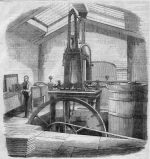How did the Victorians keep things cold?
The Victorian Ice Trade
When Queen Victoria became Queen in 1837, and for many more years, ice was cut from ponds, and from the canals. The ice was of poor quality. It was often dirty. It was an unreliable source of ice - in some years the weather was not cold enough for much ice to form.
In early Victorian times ice was imported from America, mainly from a lake called Wenham Lake which was noted for good quality ice. From the 1850's most ice used in London came from Norway. The ice formed in mountain lakes. Some artificial lakes were created to meet demand. It was cut by horse plough and by hand.
Ice was stored in London in large ice wells. Two wells are preserved beneath the London Canal Museum. They were 40 feet (12 metres) deep and about 30 feet (9 metres) in diameter. By packing ice into deep wells it could be kept for a long time until it was needed in the summer.
Ice was delivered by horse and cart every day. The ice-man would use a chisel to break off a block of ice for each customer. An ice cart had a crew of two men, and one or two horses to pull the heavy load.
Ice was used to keep all perishable fresh food cold. Meat, milk, butter, fish, and confectionery needed to be chilled. Ice was also used for ice cream making. And in hospitals ice was used to reduce swelling and as a pain killer.
The natural ice trade was in strong competition with ice made in factories towards the end of the Victorian period. Although import of natural ice did not end until around 1921, the new technology had already begun to reduce the trade in natural ice by 1900.






